Table of Contents
ToggleWhy should you utilize sustainable marketing and how
As long as you do it correctly, sustainable marketing is a terrific method to highlight your company’s commitment to the environment.
A company will naturally leverage every aspect of its genetic make-up to sell itself and differentiate itself from competitors.
Sustainable marketing is a different tactic that is gaining popularity with businesses trying to stand apart.
Governments, corporations, and individual customers are all liable for the climate issue. Therefore, depending on your objectives, promoting your eco credentials may help you gain more business accounts or boost customer loyalty.
What exactly is sustainable marketing?
A marketing approach that considers the triple bottom line of profit, planet, and people is considered sustainable. In other words, it is a strategy that aims to strike a balance between the needs of the client, the environment, and the company. In addition to the financial bottom line, it considers the effects that marketing actions have on society and the environment.
Why is sustainable marketing important?
An approach to marketing called sustainable marketing takes into account how a company’s goods and services will affect the environment and society. It considers both the demands of the existing generation and those of the following one. Sustainability marketing can sometimes be viewed as a marketing tactic used to refute charges that businesses pollute the environment and deceive consumers. Though it contains strategies comparable to those used in green marketing or eco-marketing, sustainable marketing has a broader overall focus. Sustainable marketing tries to take into account the social and economic implications in addition to the environmental impact of a company’s goods and services when Green marketing concentrates on the environmental impact.
Sustainable marketing is what you’ve experienced if you’ve ever paid a little bit more for something because you knew it was made locally or was entirely recyclable.
Businesses could adopt a variety of strategies to improve their sustainability, including:
Emphasizing eco-friendly practices
Businesses can draw attention to their eco-friendly practices and sustainability initiatives by using digital channels like their websites and social media accounts. This can include details about their use of sustainable energy sources, efforts to reduce waste, and support for environmental causes.
Encouragement of sustainable behaviors
Businesses can utilize their digital platforms to motivate their clients to adopt sustainable practices. This can include advice on how to use reusable products, promote public transportation, and use less energy.
Offering environmentally friendly goods and services
Businesses can provide goods and services that are made with a view to reducing their negative effects on the environment. This can include items made of recycled materials, tech that uses less energy, and packaging that is environmentally friendly.
Using digital tools to reduce environmental impact–Reducing waste
Using cloud-based services, virtual meetings, and electronic papers rather than physical ones will help businesses cut down on the waste that comes with digital technology. Paper waste and carbon emissions from logistics and transportation could be decreased as a result.
Collaboration with environmental groups
Businesses can work together with environmental groups to advance environmental causes and sustainability. This can involve contributing a certain percentage of profits to environmental charities, supporting environmental causes, and working together on sustainability projects.
Contributing profits to enduring causes
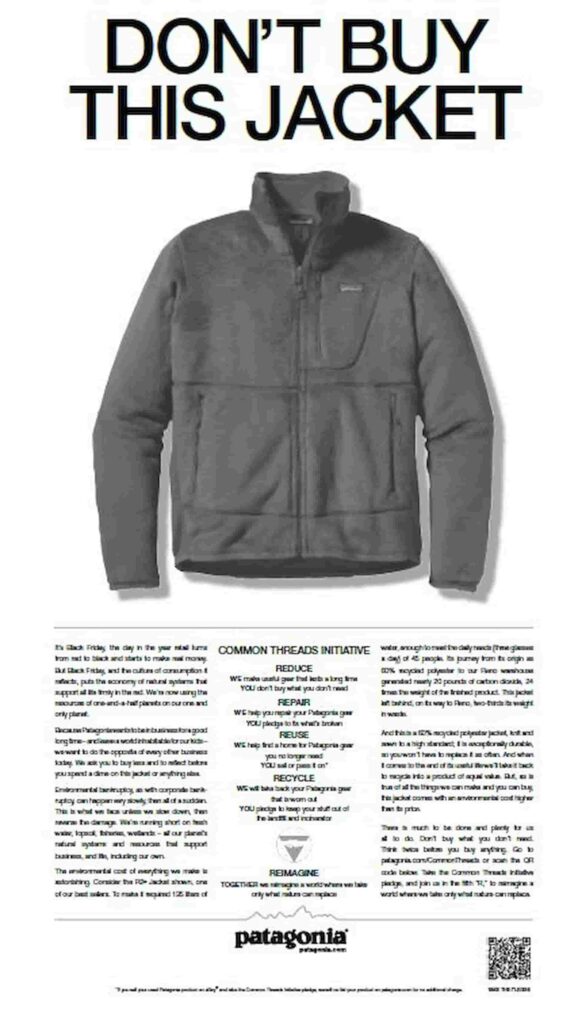
Patagonia’s “Don’t Buy This Jacket” marketing campaign was a bold and outrageous effort to promote sustainability and promote mindful consumption. On Black Friday, one of the busiest shopping days of the year, a full-page advertisement for the campaign requesting people not to buy their best-selling R2 fleece jacket appeared in The New York Times. This illogical approach was used to protest the excessive commercialization connected with the holiday season and to spread knowledge about how excessive consumption affects the environment.
In the advertisement, Patagonia highlighted that making the R2 jacket used a lot of energy and materials, which produced waste and released carbon emissions. Instead of enticing clients to acquire more goods, the firm advised them to weight the full cost of their purchases and exercise caution before making impulsive purchases. In order to promote sustainability and develop a culture of responsible consumption, Patagonia highlighted their recycling and repair initiatives as viable alternatives to purchasing new goods.
Since 1985, Patagonia is a leader in sustainable commerce. It has committed to donating 15 percent of revenues to the protection and repair of the environment. A total of $140 million by the year 2022. Additionally, by 2025, they want to be totally carbon neutral.
The great commitment of Patagonia to combating climate change and reducing their environmental footprint is shown by their goal of becoming net-zero by 2030. The business has made tremendous efforts to produce less damaging products and lessen their carbon impact. One noteworthy change they made in 2020 for the Nano Puff® jacket was to use post-consumer recycled polyester insulation instead of virgin polyester.
By using this green material, Patagonia was able to reduce the emissions linked to the Nano Puff® jacket by almost 50%. With this modification, one of their well-known goods will have a significantly less carbon footprint. In addition to reducing the need for new raw materials, Patagonia promotes a more circular economy by employing post-consumer recycled polyester, which diverts waste from landfills.
To achieve their objective of keeping global warming to 1.5 degrees Celsius, as defined by the Paris Agreement, this transition toward more sustainable materials is a crucial step. The dedication of Patagonia to lessening their carbon footprint and investing in creative solutions reflects their leadership in the sector and their dedication to being a trustworthy and environmentally friendly brand.
One of the business’s most effective environmental efforts is the Common Threads Recycling Program. Its objective was to provide clients more ways to utilize products they had already purchased.
By 2025, the packaging will be entirely recyclable, biodegradable, reused, or renewable. To reduce plastic use and use QR code technology to reduce paper use by 100,000 pounds annually, they are employing algae ink on hangtags and containers.
Patagonia is also well-known for giving 1% of all sales and 100% of Black Friday proceeds to environmental organizations.
The “Don’t Buy This Jacket” campaign was a success in getting people’s attention and starting an important dialogue about consumer behavior and its effects on the environment. By placing sustainability above short-term profits and promoting Patagonia as a trustworthy and ecologically concerned brand, it posed a challenge to the conventional marketing strategy. The campaign’s goal was to encourage a change toward more thoughtful consumption habits and advance a more sustainable future by encouraging people to think carefully about their purchases.
Promoting sustainable behaviors
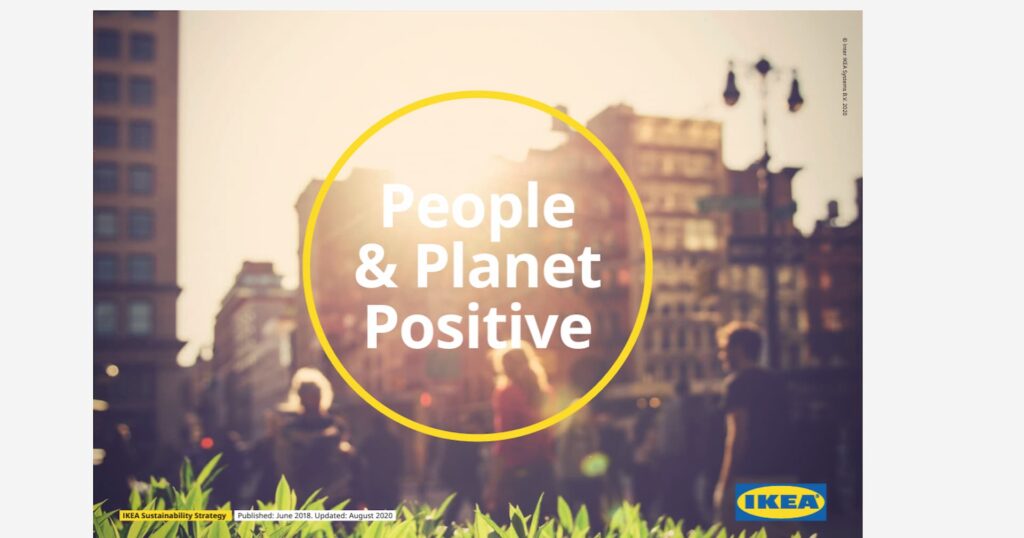
IKEA is a company that uses its website and social media platforms to promote sustainable practices among its customers. They provide advice and suggestions for minimizing waste production, energy use, and living sustainably.
It places a strong emphasis on sustainable sourcing and renewable energy, and has developed a strategy known as “People and Planet Positive” that promotes green living, solar energy, and environmental regeneration. Lessening the negative effects that the company’s operations have on the local ecosystem is the goal of this green marketing plan.
IKEA is a prime example of green marketing in action, working to reduce its already low percentage of waste to below the current 15% and to create renewable energy that accounts for 100% of the total energy utilized in its stores.
Green marketing tactics used by IKEA demonstrate their dedication to sustainability and ethical business conduct. IKEA demonstrates their commitment to lowering their environmental effect by establishing challenging sustainability goals like using recycled or renewable materials for every plastic component of their goods by 2030. This dedication positions IKEA as a pioneer in environmentally friendly furniture and home items and is in line with consumers’ rising desire for such products.
IKEA also has an excellent ecological marketing strategy by promoting the usage of reusable blue shopping bags rather than disposable ones. In addition to reducing plastic waste, this strategy encourages responsible consumer behavior. IKEA shows its commitment to decreasing single-use plastic by making reusable bags available and aggressively promoting their usage. This also motivates consumers to change their lifestyles to be more eco-friendly. This tactic not only helps to build a favorable brand perception, but it also encourages brand loyalty among customers who value and identify with IKEA’s sustainability activities.
IKEA’s dedication to sustainability, moral sourcing, and responsible consumption is demonstrated via its green marketing initiatives. These measures help to strengthen a brand that places a priority on environmental and social responsibility while also being in line with customer expectations for more sustainable products.
Partnering with environmental organizations
Sustainable marketing tactics used by TOMS include employing renewable cotton, waste and energy reduction techniques, and offering packaging composed of recycled materials.
By adopting renewable cotton in the manufacture of their shoes, TOMS minimizes their reliance on conventional cotton cultivation, which sometimes necessitates the use of pesticides and a lot of water. A more sustainable approach to agriculture is encouraged by this decision.
To underscore TOMS’ dedication to reducing its environmental impact, the company has implemented waste and energy reduction methods. The corporation wants to preserve resources and lessen its total environmental effect by improving production procedures and cutting energy use.
The use of recycled material packaging by TOMS is consistent with the ideals of sustainable marketing. The firm promotes the idea of a circular economy, in which items are reused or recycled rather than wasted, and lessens the need for new resources by using recycled materials.
These sustainable marketing techniques used by TOMS show the company’s dedication to social and environmental responsibility as well as its commitment to sustainable practices. TOMS caters to customers who are becoming more concerned about sustainability and promotes eco-friendly behavior by emphasizing these initiatives.
Eco mode
Eco mode on websites is a feature that allows users to reduce the energy consumption of their devices when browsing the web. This feature often minimizes the amount of data that must be downloaded and processed by a device, which can lead to a lower carbon footprint and reduced energy consumption.
One approach to using eco mode is to lower the quality of photos and videos, disable autoplay for multimedia material, and limit the number of scripts and animations on a page. The built-in eco modes of several web browsers, such as Google Chrome and Mozilla Firefox, can be used by users to lower their energy usage when browsing the internet.
Utilizing websites’ eco modes can help create a more sustainable digital ecosystem by lowering the carbon footprint of online activities. Additionally, it can encourage users to engage in more sustainable online behavior by increasing awareness of the environmental effects of digital technology.
Apple

Apple has worked hard to include sustainability and environmental responsibility into their marketing initiatives. The business has given sustainability top priority across a range of operational areas, including product design, energy use, and supply chain management. When they launched updated models of the MacBook Air and the MacBook Mini in 2018, they proclaimed that these products were built from aluminum that was 100 percent recyclable. This year’s slogan was “Truly Innovative products leave their mark on the world but not on the planet.”
Recyclable Materials: Apple has made a point of employing 100% recyclable aluminum in its products, including the MacBook Air and MacBook Mini. This dedication lessens the environmental effect of their products and promotes recycling and material reutilization.
Apple has made it a priority to minimize the waste of electrical and electronic equipment (WEEE) by creating durable products. The company wants to reduce electronic waste output and encourage users to keep their gadgets for longer by building robust and long-lasting products.
For both customers and the environment, Apple places a high priority on assuring the safety of the materials used in its products. To guarantee that its goods are free of hazardous materials and adhere to environmental rules, the firm has put in place stringent standards and testing procedures.
Apple has pledged to run its company entirely on renewable energy. For the purpose of powering its data centers, offices, and retail outlets, the corporation has made large investments in renewable energy sources including solar and wind power.
Through a number of marketing platforms, Apple aggressively promotes its environmental initiatives. The business’s website, social media channels, and marketing initiatives show its dedication to environmental sustainability and raise public awareness of environmental problems.
Apple wants to stand out as a company that is socially and ecologically conscious by incorporating sustainability into its marketing plans. Their marketing initiatives not only demonstrate their commitment to sustainability but also inspire customers to choose environmentally friendly products while they are buying and utilizing electrical equipment.
The Body Shop
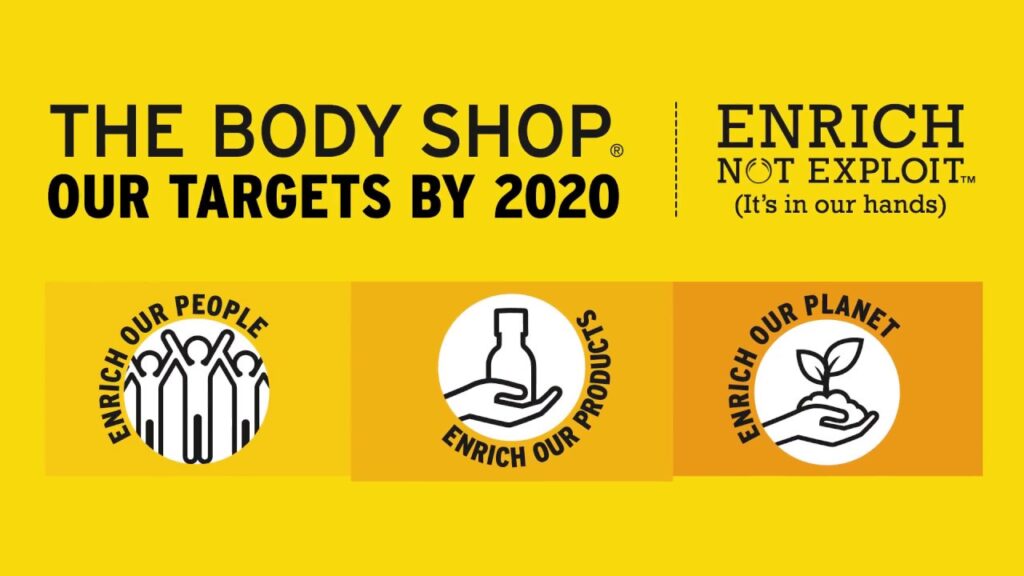
The Body Shop is a cosmetics retailer recognized for its dedication to ethical product creation and environmental sustainability and they have implemented several sustainability marketing strategies over the years.
Waste reduction: The Body Shop has put in place a number of initiatives to cut waste in their business operations, such as using recyclable and recycled packaging and utilizing fewer single-use plastics in their goods. Additionally, they encourage clients to recycle their empty product containers by bringing them in.
Promoting ethical sourcing: Is dedicated to using ingredients that are fairly traded and sustainably sourced in their products. They spread the word through their marketing platforms about their ethical sourcing methods and concerns like fair trade and deforestation.
Supporting community efforts: Is dedicated to assisting regional communities, and they advertise their community initiatives through their marketing platforms. For instance, they have started a program called Community Fair Trade that aids local farmers and craftspeople all over the world.
Marketing that emphasizes sustainability: The Body Shop uses its marketing channels to emphasize its dedication to environmental sustainability. They promote their sustainability initiatives and spread awareness of environmental issues through their website, social media platforms, and advertising campaigns.
Sustainable innovation: They have pledged to pursue sustainable innovation in both their operations and their product lines. For instance, they have introduced a line of merchandise dubbed “Refills Not Landfill,” which urges customers to reuse their empty product containers as opposed to discarding them.
The Body Shop aims to differentiate itself as a brand that is not only focused on producing quality cosmetics but also deeply committed to ethical practices, environmental protection, and community support.
Starbucks’ Green Store Initiative
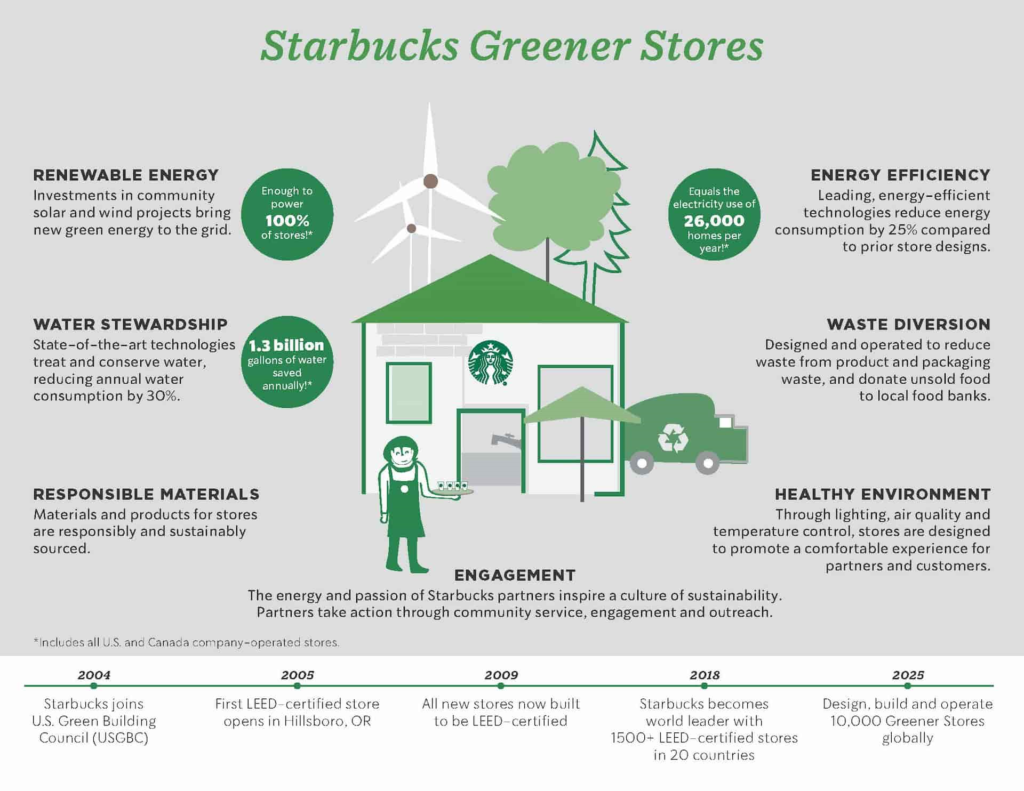
Starbucks launched its Greener Store project as part of its commitment to environmental preservation. It is a sustainability initiative designed to lessen the company’s retail operations’ negative environmental effects. It has numerous environmentally friendly design elements, such as HVAC and lighting systems that use less energy.
The Green Store project also aims to promote recycling and minimize waste in addition to these. By 2025, Starbucks wants recycling to be an option at every establishment that it owns. Starbucks has made a commitment to open 10,000 environmentally friendly outlets by 2025 in addition to eliminating plastic straws in previous years.
The company is clever in getting customers to support its green activities when it comes to its green marketing. The business offers a wide selection of reusable coffee cups in addition to coffee, which it encourages consumers to buy for their daily caffeine dose.
A Facebook campaign by the coffee business that urged people all over the world to plant trees was similarly successful. Starbucks also started a promotion called “Greener Apron” in which the company registered its employees for online sustainability and environmental stewardship training.
DressX
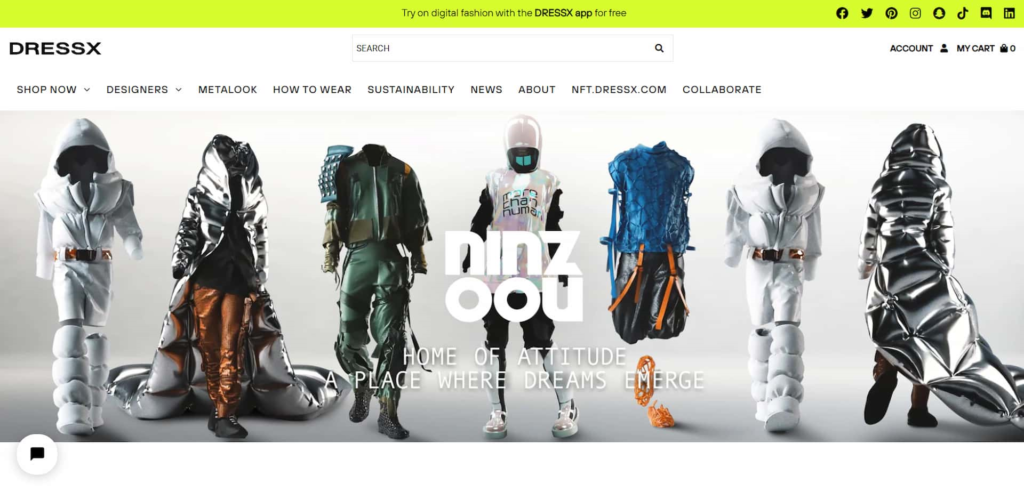
DressX is a digital marketplace for fashion, that uses sustainable marketing to cut down on apparel waste.
DressX, a firm that creates digital clothing so individuals can express themselves on social media and in virtual fashion shows, is a successful example of sustainable marketing.
A significant source of waste and pollution is the apparel industry. Take a pair of jeans as an illustration. 1,800 gallons (3,240 liters) of water, enough to bathe, drink, and wash clothes for a person for a month, would be needed to produce it. 1 Waste comes from the customer side as well. According to a study conducted in 20 European nations, the majority of people do not wear half of the clothing in their wardrobes. Up to 85% of the 2 million tons of clothing that are thrown out each year wind up in landfills.3 This might not sound too horrible, but when used clothing is burned in landfills, a lot of carbon dioxide is released into the air, polluting it.
Additionally, cheap clothing made of synthetic materials like polyester and spandex takes a very long time to decompose.
DressX offers a digital approach to deal with these problems. Therefore, people can dress in pixels and prevent the planet from needless waste instead of stocking their closets with new clothes every few weeks!
The following quotation from the business’ website exemplifies their commitment to sustainability:
We aim to evolve the Fashion industry into a more inclusive, sustainable, and accessible industry. Whether it is in the physical or virtual worlds, we still need Fashion as a means of self-expression and differentiation.
Presentations for a Philanthropic Foundation Powered by the Solar

A great illustration of a philanthropic company using green marketing techniques is the show at The Annenberg Space for Photography. The company demonstrates its dedication to renewable energy and environmental practices by illuminating photographic photographs with solar-powered light box signage. This strategy conveys a strong message about the value of implementing environmentally friendly solutions while also giving the show a distinctive and eye-catching feature.
Another persuasive element of their green marketing approach is the conversion of shipping containers into exhibition spaces. The Annenberg Space for Photography minimizes trash and the environmental effect of conventional construction methods by recycling old containers rather than building new ones. This method strengthens their environmental credentials by adhering to the sustainability and resource conservation tenets.
In addition to demonstrating their dedication to the environment, their green marketing strategies give customers a compelling and immersive experience. Such programs enable the company to clearly convey its progressive culture and commitment to environmental stewardship.
The Future
Sustainable marketing requires a genuine commitment from brands to actively participate in environmental and societal issues. Being actively involved in societal and environmental challenges demands companies to make a sincere commitment. Brands may personalize their messaging and provide consumers an additional incentive to select them over rivals by establishing themselves as active personalities in these fields.
These strategies are dedicated to making tangible changes, such as lowering carbon emissions, promoting recyclable materials, and trying to improve the future for future generations. Brands must be willing to devote their financial and operational resources to establishing eco-friendly procedures and aiding social issues if they are to fully embrace sustainable marketing.
Brands that embrace sustainability as a fundamental value and regularly uphold their commitments will not only stand out from the competition but also draw in and keep customers who value making ecologically and socially responsible decisions.
If you need advice on sustainable marketing strategies get in touch with Growthgirls







